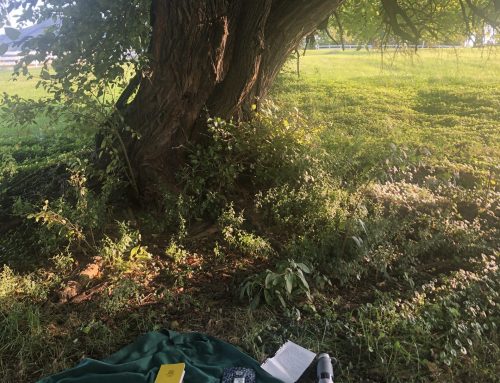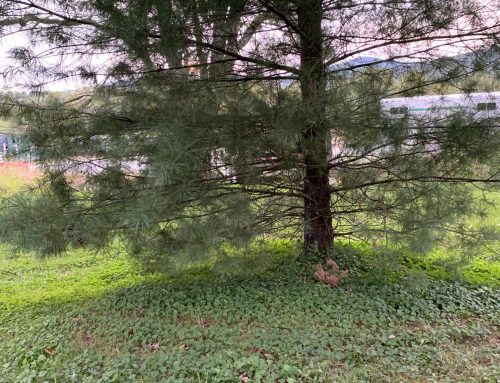My sit spot.
Early Sunday afternoon, I began the trek to my sit spot, eagerly awaiting the opportunity to observe the diverse forms of life that surround the area. However, as I was hiking through the shrubbery, I made sure to note my sit spot’s surroundings. My sit spot is located northwest of the Moody Center, past the road, and by the creek; I access this area simply by walking around the loop and coming to a halt when I recognize the scenery.
The first thing I noticed when sitting at my spot was how it was substantially colder than the last time I visited. I had intentionally chosen to wear long pants and a long sleeve top in order to prevent the manifestation of Lyme disease via a tick bite, but these garments proved to be a useful buffer against the cool winds that carried my warmth away. However, I welcomed this chilly weather as one of the first signs that fall was approaching. Despite the numbing cold, I was still able to feel the occasional tickling movement of an insect landing on my face or hands. This continuous use of my extremities as a perch made me reflect on the age-old saying: the bugs are more scared of you then you are of them. If that were truly the case, then insects must be thrillseekers, because they insisted on crawling up my legs and investigating the interloper of their environment. After reflecting on what I was feeling, I tuned
The purple wildflowers have begun to shrivel up, turn brown, and die.
into my auditory senses and tried to pick out the distinctive sounds around me. The most prominent among these noises was the rhythmic chirping of the cicadas; however, I quickly realized that their sounds became somewhat of white noise, a steady, unvarying sound. The chatter and chirping of birds perched and hidden in the trees on the opposite bank of the creek was the next sound that I diverted my attention to. The calls varied from bird to bird; some were deep and resonating while others were high pitched, shrill whistle sounds. While focusing on the calls of the wild, the occasional hum of a car engine would remind me of the nearby anthropogenic distractions;
The creek appears unchanged, despite heavy rainfall in the past week.
however, these were nothing compared to the deafening roar of plane engines in the sky. I began to wonder if the sounds created from the spacecraft disrupted natural communication in the wild because I was unable to hear anything aside from the plane when it flew overhead. Next, I tune into my sense of smell; I recognize that my sit spot provides the enormous privilege of being able to take off my mask and breathe deeply in an unpopulated area. When I take my first few deep breaths, I quickly become disappointed because I can’t place any smells. However, after continuous deep breaths, I am once again able to make out the smell of the lavender detergent I have used to wash my blanket the night before (perhaps I should stop doing laundry on Saturdays, as this smell may overwhelm the other natural scents my sit spot has to offer). I finally opened my eyes and focused on looking at and observing my surroundings. At first glance I saw the same vibrant green tall grasses that I noticed the first time I entered my sit spot; upon closer inspection, I realized that these blades of grass served as natural bridges for the ants below. Among the grasses were other various leafy plants, and interestingly enough, nearly every leaf had a hole indicative of an insect feeding there. The floral also presented a new flower that I had neglected to see beforehand; its structure seemed similar to that of lavender bloom, but instead of the staple purple color, it was bright pink. I then turned my attention to the source of the chirping and witnessed a congregation of little brown birds in the trees adjacent to my sit spot. This was a complete turnaround from the week before
The tall and wide tree that sits south of my sit spot.
because although I had heard the calls exchanged between these birds, I was unable to make them out. I then turned to observe the three objects I am following during this project: the purple wildflowers, the large tree directly to the south, and the creek west of me. I was instantly disappointed when I saw that the purple wildflowers had begun to shrivel up and die when I had previously thought that they were going to be blooming in the near future. The browning petals were indicative of this death; however, there were still a few flowers that produce vibrant purple petals. I attributed the death of this plant to the dropping temperatures and the changing of the seasons, and I suspect by the time I return the remaining petals will also be dead. I then turned my attention to the tree, which I believe is a black walnut tree; however, this has not been confirmed by anyone with the actual credentials to identify different tree species, so I wouldn’t take this deduction as true. The tree appears to be unchanged; its bark is the same whitish, brown color, and its leaves have not been shedded. Furthermore, these leaves still have numerous holes in them, serving as the food which some insect has been gorging itself on. Finally, I turned my attention to the creek, and it, too, looked as though it had been unchanged; the water level seemed to be the same as the last time I visited, which greatly puzzled me because the area has recently experienced heavy rainfall.
The first time I sat at my spot, I was content with staying stationary; there was already so much life that was directly in front of me that I feel as if I would have been overwhelmed if I had gotten up and tried to observe even more. However, this time I did notice that I wanted to look around and examine the objects I was following more closely; I hadn’t gotten a very good look at the creek. Furthermore, I wanted to explore the things I was making observations of, such as the odd splashing noises that were coming from the creek.
The purple wildflowers in comparison to the yellow wildflowers.
When I got up to finally walk around and explore my sit spot, my first instinct was to more closely inspect the items that I was following. Thus, I went up to the purple wildflowers and decided to feel the dying petals; although I expected a crunchy, hard petal I found that they were still soft to the touch (perhaps they had only died recently). I then went to look at the petals which were still full of life, but my hand recoiled when I noticed a bug nestled in the bud of the flower which I was planning on feeling. Alas, it was only a black ant situated on the soft petals, but its presence made me wonder if ants were, in fact, pollinators. I then went to inspect the creek, hoping to make out some macroinvertebrate populations because of the lab conducted only a week prior to this sit spot entry. However, I was only met with numerous insects that sat on top of the water, as well as a brown fish that was approximately half a foot long. I also noted that there was almost no turbidity of the water, and it was actually starkly clear. Juxtaposed against this clear water was the green algae forming on top of the creek, potentially caused by the nutrient runoff from campus. Finally, I walked a few feet north to look at some closeby yellow wildflowers that grew adjacent to another purple wildflower plant. I compared the two flowering plants; the leaves of the yellow flowers were much rounder than the diamond shape of the leaves of the purple flower. Furthermore, the yellow flowers had a much larger bud (approximately the size of a quarter) than the purple flower (approximately the size of a nickel).
The purple flowers grow high above the ground.
A leaf has many hairs on it as an adaptation to prevent water loss.
The first adaptation I noticed was that of the purple angiosperms that sit to the south of my sit spot. These flowers grow high above the ground due to a lack of sunlight; this lack of sunlight stems from the fact that the canopy of trees prevents much of the sunlight from penetrating the forest floor. The height of these flowers is an attempt to grow above anything that may be potentially shading them from the sun. The next adaptation I noticed were the hairs on a leaf which grow in response to water loss; these hairs provide insulation for the leaf so that when water vapor attempts to escape from the plants, it becomes trapped instead. Finally, when the brown fish I observed in the creek most likely uses a countercurrent circulation adaptation. This is an adaptation in response to low levels of dissolved oxygen in the water. The fish takes in water through its gills which moves in the opposite direction of the blood flow within the fish. The dissolved oxygen in the water will move down a concentration gradient and diffuse from the water into the blood. Furthermore, the fact that the two liquids are moving in opposite directions allows for the greatest volume of blood to be oxidized. I don’t think it was extremely difficult to make the observations regarding different adaptations because I feel as though it was easy to identify potential challenges located within the sit spot environment and conclude how these challenges would cause adaptations to rise within various organisms.



Hi Olivia! I really liked that you tried to identify the (possibly) black walnut tree. I’m glad that this time you felt more compelled to walk around your sit spot – you seem to have made a lot of observations that would’ve been difficult to make otherwise, like when you noticed the flower that looks a bit like lavender. Also, I totally relate to the confusion about the saying about insects being more afraid than you. If they were, they wouldn’t be all over my body every chance they get! Anyway, good job 🙂 I’m not sure if I missed it, but did you ever find out what the splashing in the creek was?